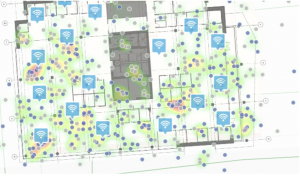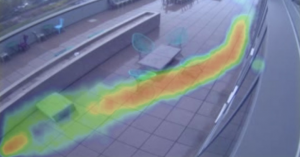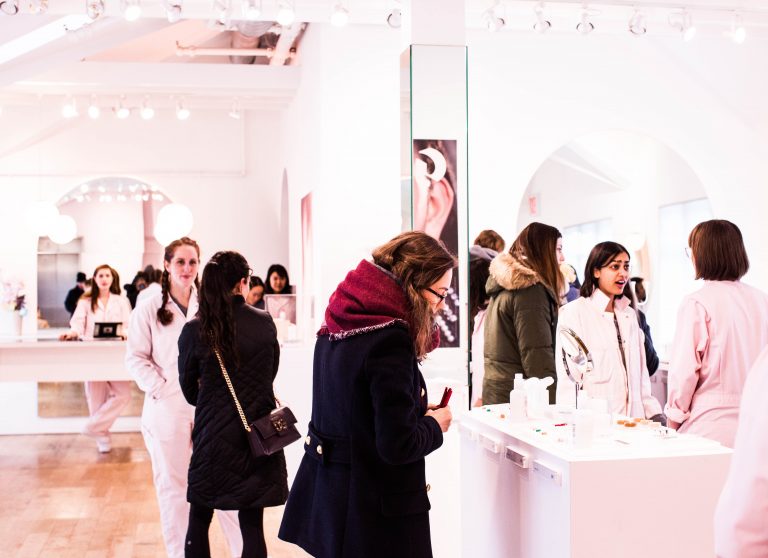By Travis Mininger, Senior Product Manager for Windstream Enterprise
When the manager at a retail sporting goods store wants to know where to locate a display promoting a flashy new line of pickleball gear to give it maximum exposure, what if they could use actual data about customer foot traffic within the store to determine optimal placement? Or, what if the owner of a restaurant that depends heavily on al fresco dining could design an outdoor table layout that elevates the dining experience without compromising server efficiency?
As enterprises that use an emerging technology called heat mapping are discovering, the seemingly random movement of customers within a brick-and-mortar retail or restaurant space have an important story to tell — a story that ultimately can reveal ways to increase sales, optimize usage of space, prevent loss and improve the overall customer experience.
Heat mapping uses an in-store WiFi network and/or specially equipped cameras to digitally record the physical movement of people within a space, then to analyze that traffic data (and synthesize it with other data sets) to establish patterns and draw insights about customer interactions with their physical surroundings, for specific locations and across multiple locations. Where retailers once had to rely largely on guesswork and gut feel to configure a space and shape the experience it provides to customers and employees, heat mapping brings fresh, objective, data-derived insight into the equation.
Heat mapping involves a combination of specially designed digital cameras on a local area network (LAN) with one or more WiFi access points, plus data capture, storage and analysis capabilities. The IP-enabled cameras themselves can capture and store data about peoples’ movements within a space, then send it to the Cloud for analysis. The WiFi network, meanwhile, tracks customers’ movements within a location from their smartphones — where they go, how they get from point to point and how long they stay in specific areas of a store.
Accumulated over a period of time, this presence data can be represented visually as an actual map indicating “hot” and “cold” spots, with areas in orange, red or pink showing high traffic and those in blue and green representing spaces where customers spend less time (see the examples below).


These maps can get as high-level or as granular as a retailer needs, with the ability to identify the individual items in a display or on a table that are the most popular, for example. What’s more, accessing heat mapping technology and analytics doesn’t require a large capital outlay. Enterprises can get it as an all-inclusive LAN service that includes the cameras, WiFi access points, LAN cabling, system upgrades, maintenance and repair, if necessary, along with data storage and analytics in the cloud. Instead of taking on the risks inherent in a capital investment, the retailer gets a predictable operating expense.
That heat mapping remains a relatively underutilized technology in the retail and restaurant businesses suggests there’s opportunity for enterprises to gain an edge by using it before their competitors do. Here are several areas where heat mapping is already proving its value to early adopters:
To better understand how placement impacts store revenue. The heat map around a particular product display shows red, yet an analysis of customer receipts indicates the products in that display aren’t meeting sales expectations. Overlaying foot traffic data with customer receipts can raise a red flag to identify scenarios where customers’ time spent at a particular display isn’t translating into sales, for example, so an enterprise can do a deeper dive to understand why. Likewise, if a product in a low-traffic section within a store is selling better than expected, that could suggest that the product deserves more prominent placement within the store.
With a better idea of how placement impacts sales, enterprises, store operators and managers can begin to develop best practices to drive revenue at the individual store level, and across a network of stores.
To identify winning (and losing) layouts. Heat mapping provides a clear understanding of where in-store customers are most likely to buy products, where they tend to linger the most (and the least), and how they tend to travel from zone to zone within a floor plan. It does so without the, “Don’t mind us while we observe your movements” creep factor. Armed with information about how the in-store environment shapes customer behavior, enterprises can tailor store design to drive sales.
On the restaurant side, heat mapping can help eateries understand how guests and employees navigate dining areas, informing table placement and overall design to maximize staff efficiency, seating capacity and the customer experience, three factors that go right to the bottom line.
To enrich the customer experience. Speaking of the bottom line, store revenues often are directly linked to the quality of the in-store customer experience. Heat mapping can help retailers improve that experience by providing data around which store layouts can be designed to improve flow and product accessibility, while alleviating congestion and other distractions.
To know your customers better. The LAN-based WiFi connections that support heat mapping also serve as collection points for customer information that a retailer or restaurant can leverage to learn more about the people who visit their stores. When a customer enters a store, the local WiFi should start to track their smart phone, providing the retailer with basic information about that customer. Even more personal and demographic data should become available when that customer opts to engage with the in-store WiFi, such as via a captive portal like Facebook. The more data they can collect about the people who visit a store, the more analytics fodder they have to use in tandem with heat mapping to better understand customer behavior.
To prevent loss and boost security. Beyond recording and storage capabilities, the IP-connected digital cameras used for heat-mapping also can help stores identify areas that may be particularly vulnerable to theft, which in turn can reduce loss and improve overall security. By correlating inventory loss data with heat mapping, store managers can better understand how to configure their layouts to prevent theft/loss, for example. Using the video review features built into these cameras, a store manager also can quickly pinpoint the exact moment an item was removed from a specific shelf within a display.
With capabilities like these that can improve decision-making and directly impact the bottom line, heat-mapping has the look of a technology that retailers and restaurants will quickly warm to.
About the author

Travis Mininger is Senior Product Manager for Windstream Enterprise, where he is
responsible for LAN services, managed LAN/WAN, managed network services and hospitality WiFi solution portfolios. He has over 15 years of experience managing many different products and services with a strong background in LAN, CPE-based and security-based services. Travis joined Windstream in 2017 and held previous product management positions with Broadview Networks and EarthLink.
Related Articles

Hexnode CEO on how the “Holiday Illusion” is Masking the Risks of Retail’s Seasonal Workforce
The danger of seasonal hires is magnified not just by who is accessing the network, but when they are doing it. Sophisticated threat actors possess a deep understanding of the retail operational calendar.

The New Frugality: How Inflation and Tariffs Are Reshaping Consumer Spending
One of the most telling shifts is how shoppers approach decision-making. Where convenience once dominated, consciousness now plays a larger role. People are researching more before making a purchase, comparing prices across multiple platforms, and questioning whether they really need the product in the first place.

Embracing new concepts vs the return to brick-and-mortar
Balancing the return to physical retail and the development of new technologies to enhance customer experience and drive operational efficiency for long-term success.
Enartis to Acquire Parsec in Winemaking and Retail Deal
The deal will bring Enartis and Parsec together to help wineries manage every part of production more easily and efficiently, from grape to bottle.


 for the latest news and job opportunities in retail tech
for the latest news and job opportunities in retail tech 